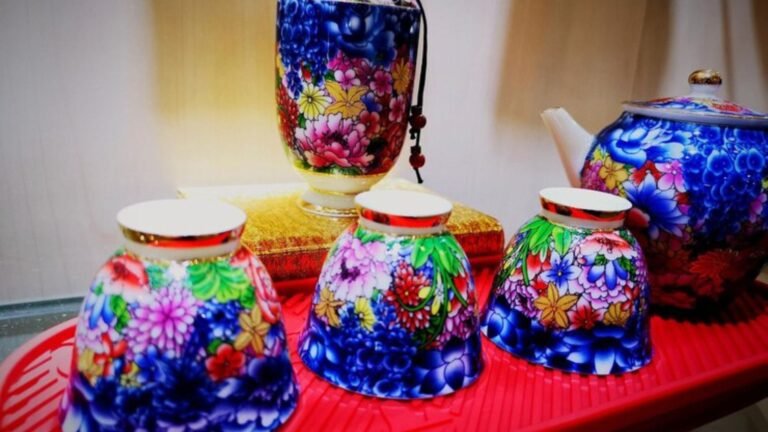Imari porcelain, known for its vibrant colors and intricate designs, is one of the most celebrated types of Japanese ceramics. Originating from the Arita region in Japan during the early 17th century, Imari porcelain has captivated collectors and art lovers around the world. This article delves into the rich history, distinctive features, production techniques, and enduring appeal of Imari porcelain, while providing insights into its significance in both cultural and artistic contexts.
History of Imari Porcelain
Origins in Arita
The history of Imari porcelain begins in the small town of Arita, located on the island of Kyushu. The discovery of kaolin clay in the area in the early 1600s set the stage for porcelain production. Arita artisans, inspired by Chinese porcelain techniques, began to create their unique style, leading to the establishment of a thriving pottery industry.
Rise to Popularity
By the mid-17th century, Imari porcelain was being exported to Europe and other parts of Asia through the port of Imari. Its stunning designs and vivid colors quickly gained popularity, especially among European aristocrats. The distinctive blue and red hues, often combined with gold accents, became synonymous with luxury and elegance.
Influence of Western Demand
The demand for Imari porcelain’s surged in the late 17th and early 18th centuries, particularly in France and England. European potters attempted to replicate its style, but nothing matched the authenticity and quality of Japanese craftsmanship. As a result, Imari porcelain’s became a status symbol, adorning the tables and display cabinets of the wealthy.
Distinctive Features of Imari Porcelain
Color Palette
Imari porcelain’s is renowned for its striking color palette, predominantly featuring cobalt blue, rich red, and gold. The cobalt blue is often used for intricate underglaze designs, while the red is applied as overglaze, giving the pieces a three-dimensional effect. The use of gold highlights adds a luxurious touch, enhancing the overall visual appeal.
Design Motifs
The designs on Imari porcelain’s are diverse, often incorporating traditional Japanese motifs such as flowers, birds, and geometric patterns. Common themes include:
Floral Patterns: Cherry blossoms, chrysanthemums, and peonies are popular, symbolizing beauty and transience.
Animals: Cranes and turtles, representing longevity and good fortune, frequently appear in the designs.
Geometric Shapes: Hexagons, circles, and other shapes create a harmonious balance and structure in the artwork.
Shape and Form
Imari porcelain’s is crafted into various shapes, from dishes and bowls to vases and figurines. Each piece is meticulously shaped, ensuring a balance between aesthetics and functionality. The smooth, glossy finish is a hallmark of high-quality Imari porcelain, making it visually striking and tactilely pleasing.
Production Techniques
Traditional Methods
The production of Imari porcelain’s involves a meticulous process that has been passed down through generations. Key steps include:
Clay Preparation: Artisans begin by preparing high-quality kaolin clay, which is essential for producing fine porcelain.
Forming: The clay is shaped using potter’s wheels or molds, depending on the desired form.
Drying and Firing: After shaping, the pieces are dried and fired in a kiln at high temperatures, ensuring durability.
Glazing: A transparent glaze is applied, enhancing the piece’s beauty while protecting it.
Decoration: Artists use underglaze and overglaze techniques to add intricate designs, followed by a second firing to set the colors.
Modern Techniques
While traditional methods remain vital, contemporary artisans have embraced new technologies to enhance production efficiency and creativity. Digital tools aid in design, while advanced kilns allow for more precise temperature control, resulting in higher quality porcelain.
The Cultural Significance of Imari Porcelain
Symbol of Heritage
Imari porcelain’s is not just a decorative item; it embodies Japan’s rich cultural heritage. The artistry reflects the country’s history, traditions, and aesthetics, making each piece a testament to Japanese craftsmanship.
Role in Tea Ceremonies
Imari porcelain’s has also played a significant role in traditional Japanese tea ceremonies. The elegance and beauty of the pieces elevate the ceremony, enhancing the experience of both the host and guests.
Collectibility and Investment
In recent years, Imari porcelain’s has gained attention as a collectible item, with antique pieces fetching high prices at auctions. Collectors appreciate not only the beauty of the porcelain but also its historical context, making it a worthwhile investment.
Caring for Imari Porcelain
To maintain the beauty and integrity of Imari porcelain, proper care is essential. Here are some tips:
Cleaning: Use a soft, damp cloth to wipe surfaces. Avoid harsh chemicals that may damage the glaze.
Storage: Store pieces in a cool, dry place, away from direct sunlight, to prevent fading and cracking.
Handling: Handle with care, as Imari porcelain’s can be delicate. Use felt pads or soft cloths when stacking to prevent scratches.
Conclusion
Imari porcelain’s stands as a timeless symbol of Japanese artistry and craftsmanship. Its rich history, vibrant colors, and intricate designs have made it a cherished collectible and a key element of Japan’s cultural heritage. As the demand for unique and meaningful art continues to grow, Imari porcelain’s remains a testament to the enduring beauty of traditional Japanese ceramics.
ALSO READ:Ufimsky Aviation University: A Hub for Aeronautical Excellence
FAQs
What is Imari porcelain made of?
Imari porcelain is primarily made from high-quality kaolin clay, which is fired at high temperatures to create durable and fine porcelain.
How can I identify authentic Imari porcelain?
Authentic Imari porcelain often features vibrant blue and red colors, intricate hand-painted designs, and a smooth, glossy finish. Look for the “Arita” mark, which indicates its origin.
Is Imari porcelain safe to use for food?
Yes, many pieces of Imari porcelain are safe for food use, but it’s essential to check for any lead-based glazes or coatings, especially in antique pieces.
How can I tell the age of my Imari porcelain?
The age of Imari porcelain can often be determined by its markings, style, and production methods. Consulting an expert appraiser can provide more accurate insights.
Where can I buy Imari porcelain?
Imari porcelain can be purchased from antique shops, auctions, online marketplaces, and specialty stores that focus on Japanese art and ceramics.

